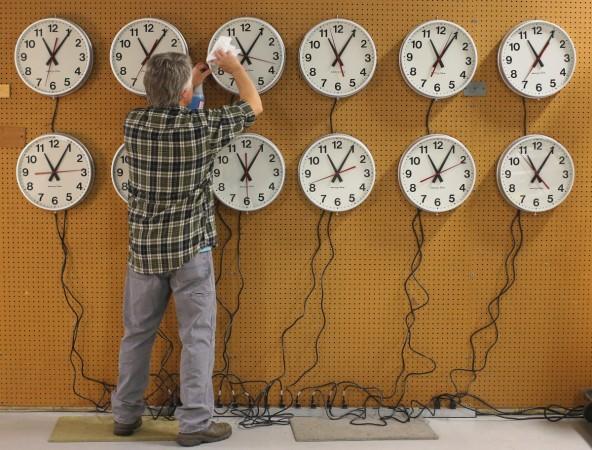
A team of physicists about 14 years back gathered 12 of the world's most accurate clocks, set them up and watched them tick. They continued to watch the clocks tick as part of an important experiment to prove the laws that govern physics as they stand.
The experiment, run by Bijunath Patla and his team at National Institute of Standards and Technology in Boulder, Colorado, started to stare at clocks starting November 1999 and monitored about 450 million seconds, or about 14 years. Their study was finally published this week and the result of the experiment was quite profound, reports Wired.
Between November 1999 to October 2014, Patla's team watched these atomic clocks constantly. They even managed to take the clock to different locations in the universe, without even leaving the lab. "We've moved the lab 14 times around the sun," says Patla. Every second, the planet is travelling through the universe, so technically, these measurements were made in different points.
So, what was Patla and his team hoping to find with this test? They wanted to find out if Einstein's theory of general relativity actually holds true. According to the theory, which also demonstrates one of the most fundamental principles in physics- there is no place or time in the known universe that is "special", or does not fall into the laws that have been identified and put together here on Earth.
General relativity covers everything from how planets orbit stars to how stars die, collide and produce ripples in the form of gravitational waves. Also, through time, the laws of physics remain unchanged- that is to say that it was the same when the universe was born about 13 billion years back and will remain the same in future as well. Physical laws govern how matter reacts and responds to forces and none of them has changed since they were first created, so a ball falling from a building, fell the same way in the 1600s and does so at the exact same rate today as well.
Having said that, this experiment wanted to find out if this was actually true. How do we know for a fact that the laws of physics remain unchanged from day to day? Without actually testing it, saying that physical laws do not change is only an assumption, notes the report. What if humans are just unable to perceive changes as they happen?
"The modifications might be very, very small," says physicist Nicolas Yunes of Montana State University, who was not involved in the experiment. "Everything we measure is approximate," he says. "If you're measuring distance with a ruler, you can only measure up to the accuracy of the ruler."
If there are indeed minor changes happening, the only way to catch them is to perform highly accurate experiments again and again, in as many locations as possible. If outcomes change, then it is one way to see first hand that a law of physics has changed, even by a small margin. Patla's team decided to test it by looking at clocks and the way they tick for 14 years.
Atomic clocks were chosen by the team because, according to the report, they are among the most accurate machines ever built by humans. They are used to tell time using the steady beat of an atom. Clocks used by the team were designed to emit light waves and oscillate several billion times every second. The clocks count these light cycles. They are also extremely accurate, notes the report. In fact, they are so accurate that they will not lose a second in millions of years.
The experiment, however, was not just interested in keeping time, says the report. They were actually studying the light that came from within the atom inside the clock. Atom's electrons and nucleus have a measurable level of magnetism that causes a slight push and pulls on each other. The team wanted to observe this phenomenon.
The clocks were placed in a temperature and climate controlled environment notes the report. "If the temperature changes more than 0.5 degrees, they'll get alarms to go fix it," says Patla. "Most of it is automated, but someone watches it all the time, and someone carries a beeper." Every single environmental effect can be covered and has been accounted for- including the Earth's gravity.
Patla's team is now planning to continue this experiment all over again with upgraded clocks. They want to be able to look at this magnetic interaction within atoms with three times more precision than they have so far, notes the report.
















